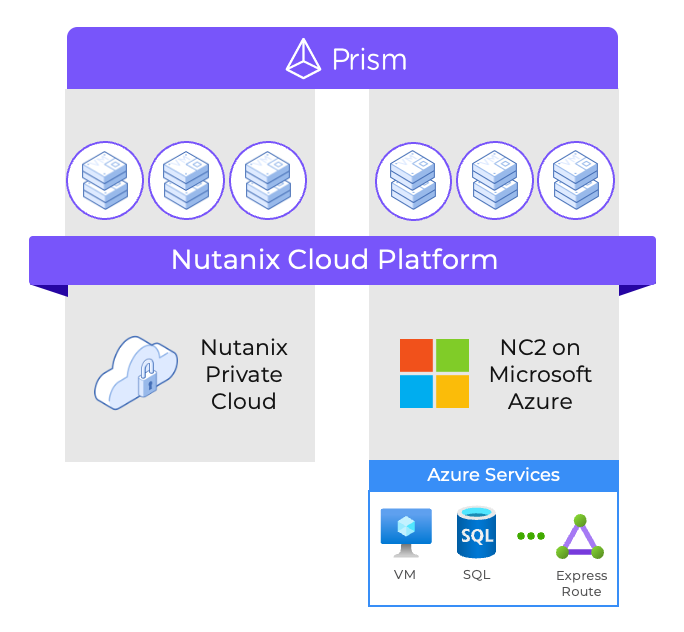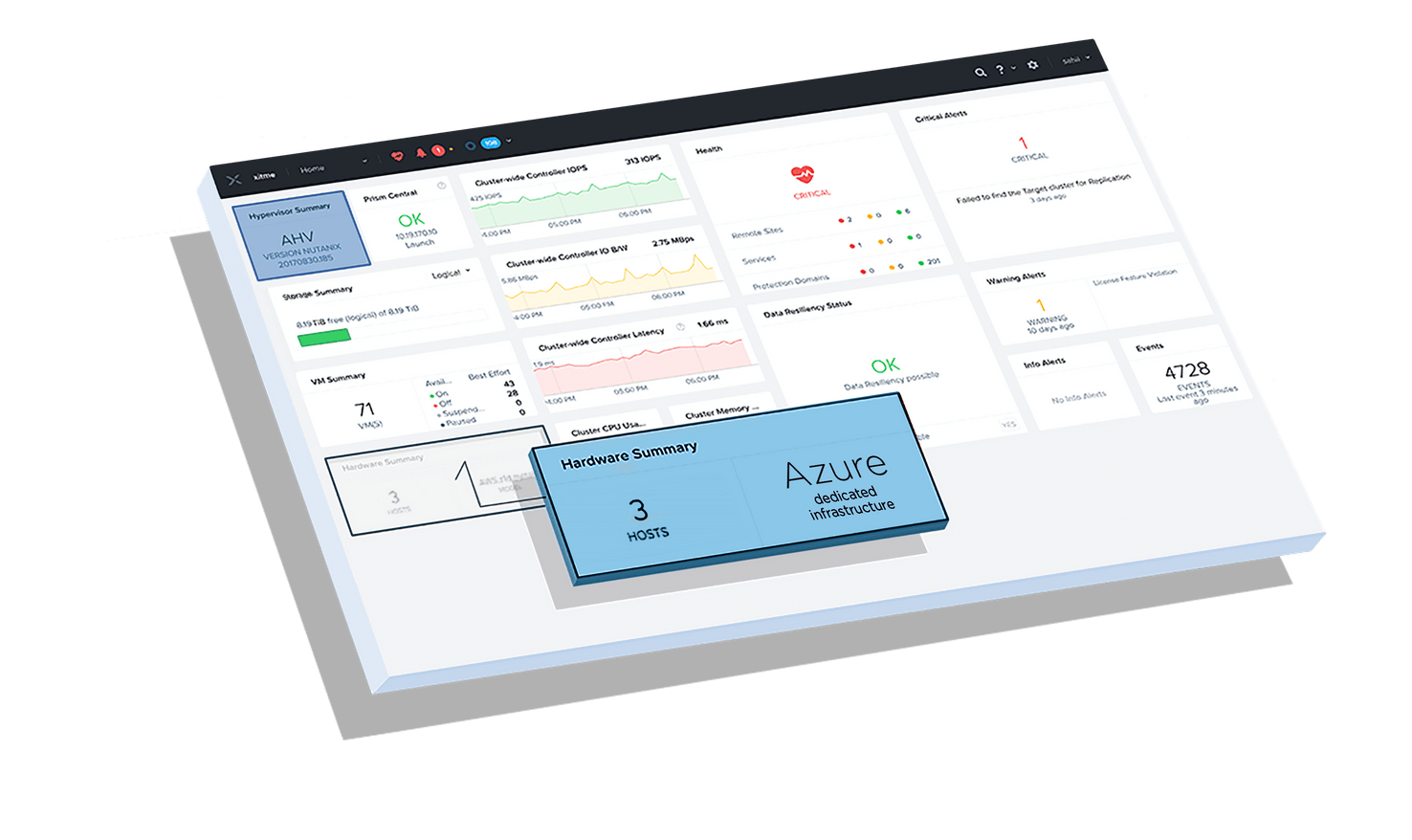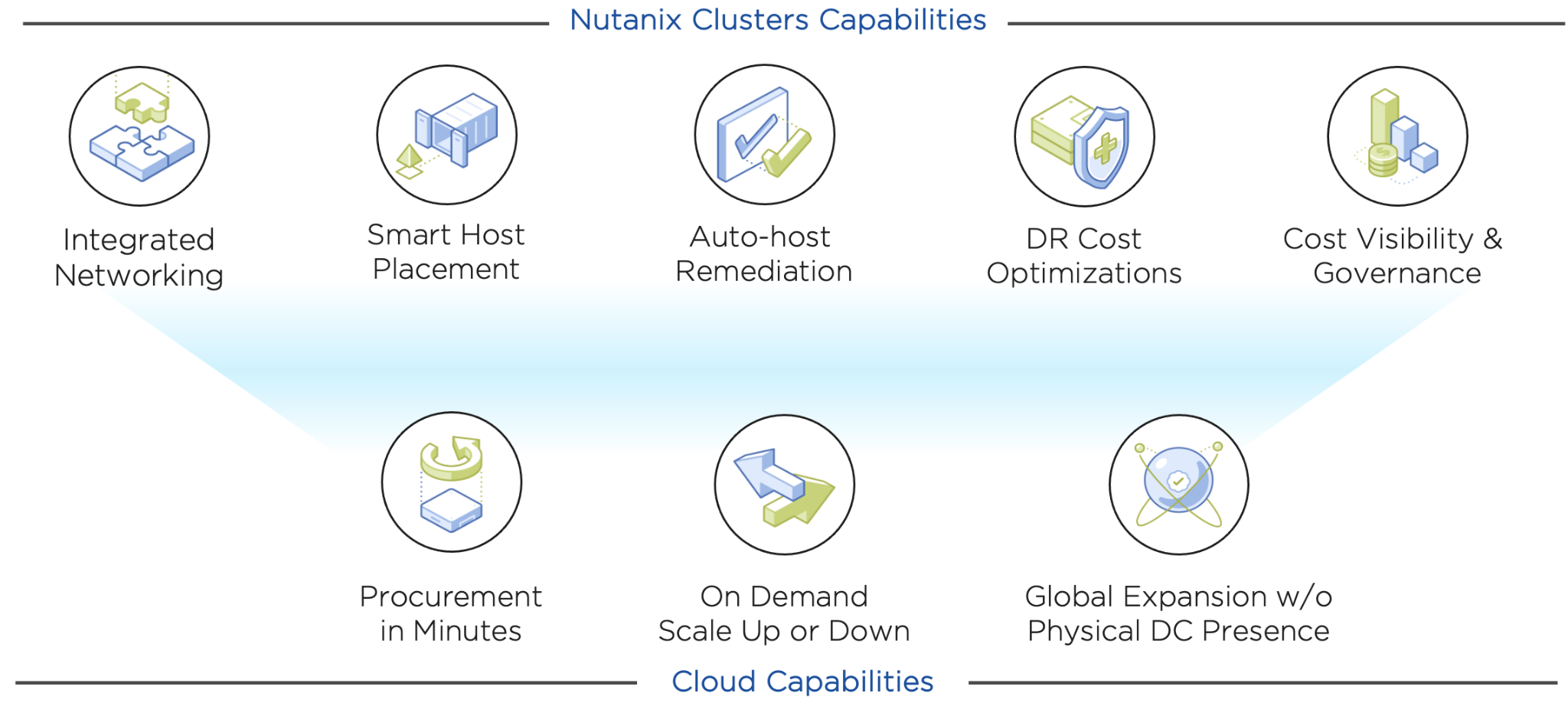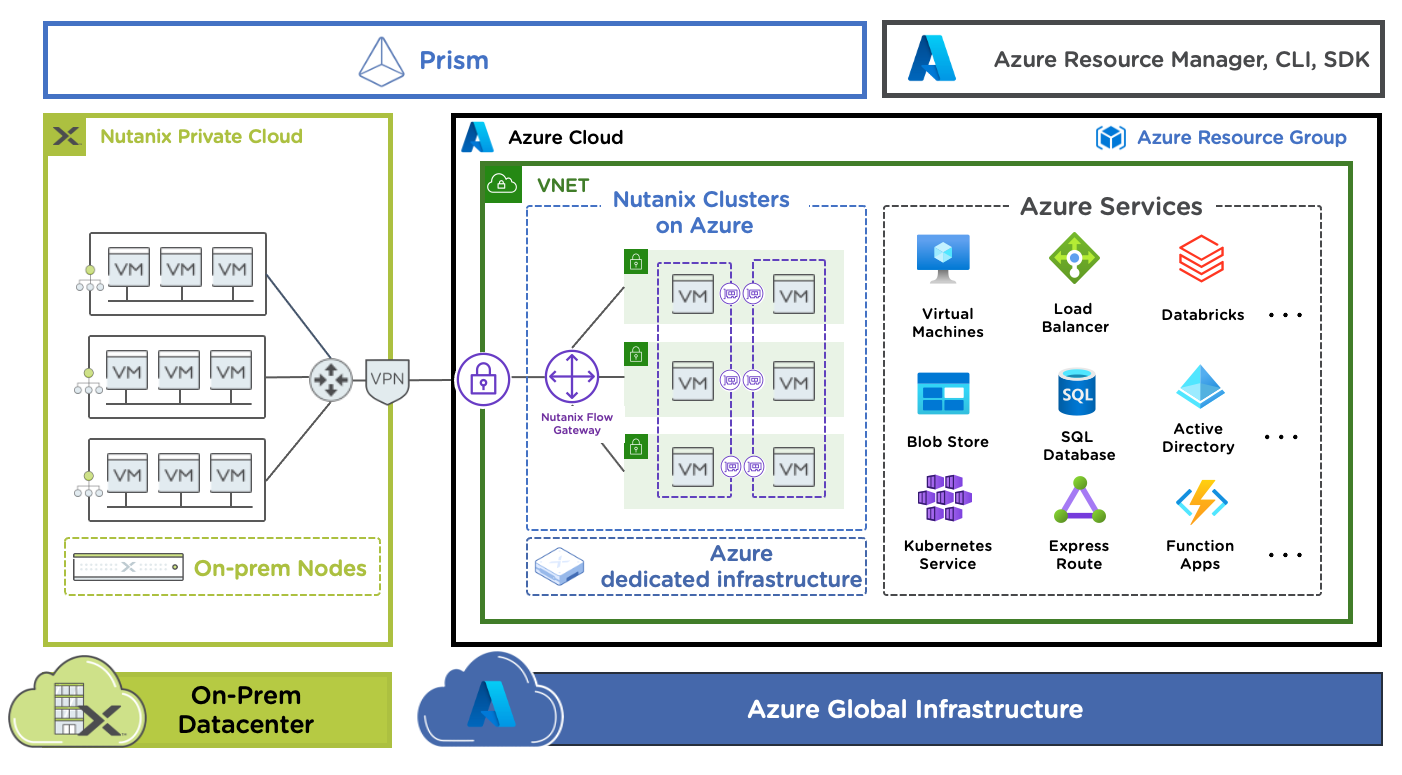In recent years, and the last 18 months in particular, IT teams have been under pressure to become more agile to support an increasingly hybrid workplace amidst ever evolving business needs. Many businesses have packed years’ worth of digital transformation efforts into a short span of time while operating under reduced budgets. Both private and public cloud vendors are striving to better serve their customers’ needs, which frequently includes running workloads on a mix of on-premises and cloud infrastructure, dictated by workload and business needs.
While the idea of a Hybrid Cloud architecture has been around for a while, there have been several challenges that prevented rapid adoption of hybrid cloud platforms. Managing complex networking between on-premises datacenters and public clouds has been a long-standing obstacle, and re-architecting legacy applications for the cloud can be time-consuming and expensive. Another issue has been the inefficiency created by silos of using multiple different management tools for various clouds.
To address these challenges and power their customers IT needs to the next level, Nutanix is collaborating with Microsoft on hybrid cloud solutions that help blend the boundaries between cloud and on-premises for a true hybrid cloud experience.
Now In Preview: Nutanix Clusters on Microsoft Azure
We are delighted to announce that Nutanix Clusters™on Microsoft Azure® is now in limited preview! Nutanix is working with Microsoft to eliminate the traditional silos between datacenter and cloud so that our customers can realize the benefits of both their on-prem and Azure environments with a unified management plane, seamless mobility across clouds, while leveraging their existing investments in Nutanix and Microsoft. For workloads running on a Nutanix Cluster on Azure, customers can also easily access Azure services.
In addition to Nutanix Clusters on Azure customers can also use Azure Arc for Kubernetes to manage their Kubernetes containers running on Nutanix as well as in their Azure-native environment making it easier to modernize their legacy applications.
“We kept customer needs front and center when deciding the architecture of our hybrid cloud platform with Microsoft Azure. With a fast deployment time of under an hour, a unified management plane across on-prem and Azure, and built-in networking capabilities, Nutanix Clusters truly makes the complexity of managing hybrid cloud infrastructure invisible to the customer”, said Thomas Cornely, Senior Vice President of Product Management at Nutanix.

A Hybrid Cloud with Nutanix and Microsoft Azure
3 Easy Steps to a Hybrid Cloud
Nutanix Clusters is built upon the industry leading Hyperconverged Infrastructure (HCI) software including the Nutanix hypervisor, AHV®, and the management plane, Prism®. Nutanix Clusters on Azure makes it very easy for customers already using Nutanix HCI software in their datacenter to integrate their on-premises Nutanix environment with Nutanix on Azure, delivering a true lift-and-shift experience they need to get the full benefits of a hybrid cloud architecture.
Build and operate hybrid cloud with Nutanix and Azure in 3 simple steps:
- Deploy Nutanix on Azure: Users will start with the Nutanix Clusters deployment console and configure their Azure account. This global service provides deployment automation, cluster lifecycle management, Identity and Access Management (IAM), Role-Based Access Control (RBAC), security, scaling, metering, logging and other functions related to cloud distribution. It continuously monitors the health of the bare-metal instances in the Azure cluster and executes the required remediation actions if any of the instances get into a degraded state.
Users will decide the number of nodes in their cluster (up to a maximum of 16 nodes) and the Nutanix Clusters deployment console will install the Nutanix HCI software, AHV hypervisor, and Prism management plane on Azure dedicated infrastructure. The Clusters console will also automatically install Nutanix Flow Networking™ along with Flow Gateway VMs in the user’s Azure VNet. The Gateway VM will provide connectivity to user VMs on Nutanix when using Flow networking.
- Unify on-prem and Azure environments: Once Nutanix software is installed and launched on Azure nodes, you can use the Nutanix Prism Central management plane to unify your on-prem and cloud infrastructure. The same Prism Central instance can be used to manage day-to-day cluster administration, monitoring and workload operations for all Nutanix clusters, on-prem or in public cloud. This also means organizations can easily use their existing tooling, third-party integrations, operational practices policies, etc., on Azure similar to their on-prem Nutanix infrastructure.
It is the same Nutanix experience everywhere, delivering a truly unified solution and allowing customers to choose the right cloud for the right workload without lock-in.
- Migrate workloads with ease: The key benefit of this hybrid cloud architecture is a true lift-and-shift experience across different environments. All the VMs, snapshots, containers, and data can move as-is from Nutanix on-prem to Nutanix on Azure, or vice-versa. Simply use the built-in protection policies to replicate your VMs and applications on the Azure nodes. Or use the Nutanix Move™ tool to migrate your VMs and applications completely on the Azure nodes and consolidate your datacenter capacity
"Our partnership with Nutanix helps customers accelerate and simplify cloud adoption. Along with Nutanix Clusters on Microsoft Azure, customers can use Azure Arc-enabled Kubernetes on Nutanix to manage containerized applications consistently across Azure and on-prem, enabling a seamless hybrid experience”, said Eric Lockard, Corporate Vice President of Azure Specialized at Microsoft

Use Prism Central to manage a Nutanix cluster on Azure along with Nutanix on-prem clusters
Feature Highlights
Nutanix Clusters on Azure includes certain capabilities that are driven by Azure and certain capabilities driven by Nutanix. These key features are:
- Procurement in Minutes: The inherent agility of public clouds like Azure allows users to provision bare-metal instances in their existing cloud accounts within just a few minutes.
- On-demand Scale Up or Scale Down: Using Nutanix Clusters, users can easily scale their cluster capacity. Add more nodes when workload demand increases or cut back to save costs when possible, all with just one-click.
- Global Expansion without Physical Datacenter Presence: Run your workloads in any supported Azure region anywhere in the world without having to manage your own datacenter in that geographic region.
- Integrated Networking: Nutanix Clusters on Azure comes with integrated networking capabilities using the Nutanix Flow networking solution. An internal subnet in the Azure VNet is used to route the traffic from Flow VPC VMs to Gateway VMs. An external subnet in the same VNet is used to route the traffic outside the Flow VPC.
- Smart Host Placement: The Nutanix Clusters deployment console uses a built-in host placement algorithm to make your cluster resilient against rack failures by intelligently routing the hosts across many different racks and recovering your data in another rack if a full rack failure occurs.
- Auto-host Remediation: Nutanix Clusters continuously monitors the health of your Azure nodes, automatically provisions a new host and recovers your cluster health if a host failure occurs.
- DR Cost Optimizations: Keep a small 3-node cluster running 24/7 on Azure and rapidly expand the cluster size to its full capacity (say, 10 nodes) only when a disaster recovery (DR) need arises. This can lead to a more cost-effective solution than keeping all 10 nodes provisioned 24/7 for a DR on-prem scenario.
- Cost Visibility & Governance: Nutanix offers out-of-the-box visibility into hybrid cloud resource costs along with cost saving recommendations to help keep your cloud spend under control.

Key features of Nutanix Clusters on Azure
Key Use Cases & Supported Regions
Business Continuity & Disaster Recovery: A key hybrid cloud use case is to ensure business continuity during planned or unplanned downtime. You can use Azure regions as the DR target for your applications and recover within minutes of a DR event. This eliminates the need to reserve secondary datacenter capacity for DR needs. Simply use any supported Azure region and Nutanix Clusters can help you automate the DR process to recover your critical applications.
On-demand Capacity Bursting: Automatically burst resource capacity into Azure to address seasonal or just-in-time increase in demands instead of reserving excess datacenter capacity that may not be needed at all times. You can also more rapidly provision resources for your dev/test teams thereby increasing developer productivity.
Frictionless App Migration to Azure: Accelerate your Azure adoption by migrating legacy applications from on-premises environments to Azure with no re-tooling, no code change. Get to Azure faster by eliminating the complexity and cost associated with traditional migration efforts. Easily integrate with Azure services to modernize your applications.
Supported Regions
The preview currently supports US East and US West 2 Azure regions. In the two US regions, the Azure dedicated infrastructure will have 36 cores, 576 GB memory and 3.2TB NVMe SSD storage. Other global regions are expected to be supported in the near future. For details of supported regions, please visit the Nutanix Clusters on Azure website.
“Société Générale has decided to adopt a hybrid cloud strategy. To implement such a strategy, companies need partners like Nutanix and Microsoft, who can help them build, operate, secure, and monitor a hybrid cloud environment.” said Khaled Soudani, Group Deputy Chief Technology Officer, Société Générale
Network and Storage Architecture
With Nutanix Clusters on Azure you will be able to use your existing Azure accounts and networking setup (VPN, VNet, and Subnets), which makes it easy to deploy and manage the hybrid cloud. During the cluster creation process you will deploy a Prism Central instance and use Flow networking on your Azure clusters. To provide the network connectivity between your user VMs running in Nutanix clusters on Azure and an on-prem cluster, Flow Gateway VMs are deployed in your Azure VNet.
You can use your preferred method to connect the Azure VNet to your on-prem datacenter such as a VPN connection or Azure Express Route. The Nutanix Cluster on Azure can use built-in DR, backup and replication capabilities, allowing seamless mobility of stateful applications from on-premises to Azure and back. User VMs running on Nutanix in Azure are also able to easily connect to all Azure services.

Network architecture for hybrid cloud with Nutanix and Azure
The Nutanix cluster on Azure comes with the Nutanix hypervisor, AHV. AHV exposes local NVMe storage to controller VMs (CVMs) to manage storage across different bare metal instances. The CVMs cluster together and provide a single storage fabric across all nodes with all the enterprise storage capabilities that enterprise apps need. While AHV is installed in the Nutanix Clusters on Azure, you can have any Nutanix supported hypervisor in your on-premises clusters or even use a 3-tier, non-Nutanix environment to migrate VMs from on-prem to Nutanix Clusters on Azure.
Maximize Existing Investments in Nutanix and Microsoft
During the preview, both the Nutanix software and Azure dedicated infrastructure are free for users. However, when the solution is generally available, customers will be able to subscribe to Nutanix Clusters from the Azure Marketplace, allowing them to utilize their existing Microsoft Azure Consumption Commitment (MACC) to purchase both Nutanix software and Azure dedicated infrastructure. Nutanix customers will also be able to port their existing licenses to Nutanix Clusters on Azure, enabling frictionless movement between private and public clouds. In addition to portable licenses, Nutanix customers will have the option to choose from pay-as-you-go or consumption based annual subscription models for Nutanix Clusters.
Bringing Cloud Practices On-Premises With Azure Arc
The Nutanix and Microsoft collaboration between Nutanix Karbon and Azure Arc enables powerful container and data services management on Nutanix HCI, on-premises or in Azure. This integration allows customers to optimize and extend unified infrastructure management to operate key Azure services in their Nutanix environment, including running Azure Arc-enabled SQL Server, Arc-enabled Kubernetes, and Arc-enabled data services. This helps Nutanix customers to bring Azure services on-premises, and helps Azure customers with centralizing management of their key infrastructure and data across Azure and Nutanix HCI. Customers can extend key Azure Arc control plane functionality, like resource groups, RBAC, audit, and more to their Nutanix environment and modernize their legacy applications over time. The customer services team at Nutanix and Microsoft are ready to deliver Enterprise class support through this partnership.
Hybrid Cloud Freedom with Nutanix and Microsoft Azure
Nutanix and Azure are meeting today’s IT needs with hybrid cloud solutions. You can start your datacenter transformation with HCI as your private cloud foundation and then move to a hybrid cloud environment. The result? Migrating applications and data across to Azure without operational friction or lock-in to the underlying platform
- A Hybrid Cloud infrastructure that keeps you in complete control
- Ability to use existing Azure accounts with integrated networking making it easy to deploy and manage your infrastructure
- Seamless application and workload migration without re-tooling which greatly accelerates Azure adoption
- Single management plane for servers, containers, and data services providing a seamless hybrid experience
With Nutanix Clusters you get an easy on-ramp to Azure without having to learn a lot of new skills. Confidently plan your long-term hybrid cloud strategy for all your infrastructure needs - on-prem and in Azure - and greatly accelerate your cloud journey with Nutanix and Azure.
Visit nutanix.com/azure to learn more about our hybrid cloud infrastructure and sign up for preview access.
© 2021 Nutanix, Inc. All rights reserved. Nutanix, the Nutanix logo and all Nutanix product, feature and service names mentioned herein are registered trademarks or trademarks of Nutanix, Inc. in the United States and other countries. Other brand names mentioned herein are for identification purposes only and may be the trademarks of their respective holder(s). This post may contain links to external websites that are not part of Nutanix.com. Nutanix does not control these sites and disclaims all responsibility for the content or accuracy of any external site. Our decision to link to an external site should not be considered an endorsement of any content on such a site. Certain information contained in this post may relate to or be based on studies, publications, surveys and other data obtained from third-party sources and our own internal estimates and research. While we believe these third-party studies, publications, surveys and other data are reliable as of the date of this post, they have not independently verified, and we make no representation as to the adequacy, fairness, accuracy, or completeness of any information obtained from third-party sources.
This post may contain express and implied forward-looking statements, which are not historical facts and are instead based on our current expectations, estimates and beliefs. The accuracy of such statements involves risks and uncertainties and depends upon future events, including those that may be beyond our control, and actual results may differ materially and adversely from those anticipated or implied by such statements. Any forward-looking statements included herein speak only as of the date hereof and, except as required by law, we assume no obligation to update or otherwise revise any of such forward-looking statements to reflect subsequent events or circumstances.
Product features or enhancements described in this post as early access may be subject to change at any time, without notice, and we provide no assurances, and assume no responsibility, that early access product features or enhancements will be introduced in the timeframe or manner presented or at all. No purchasing decisions should be made based upon reliance of early access features. We reserve the right at any time not to release a generally available version of the early access features or, if released, to alter prices, features, licensing terms, or other characteristics of the generally available release.

